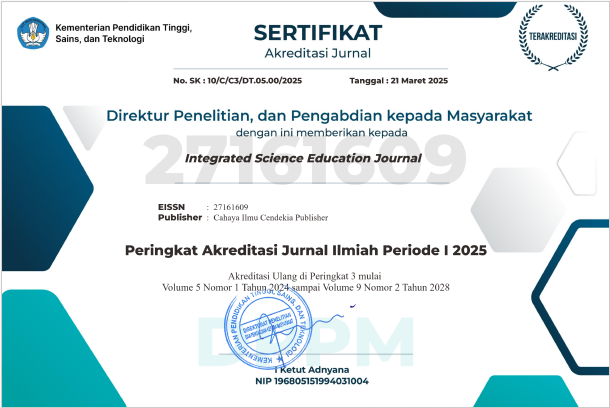Identifikasi Minat Siswa dalam Belajar Materi Hubungan Antara Bentuk dan Fungsi Bagian Tubuh Hewan dan Tumbuhan
Abstract
Tujuan Penelitian: Untuk mengetahui minat siswa dalam belajar pada materi hubungan antara bentuk dan fungsi bagian tubuh hewan dan tumbuhan di kelas IV SD Negeri 122/IX Petaling
Metodologi: menggunakan korelatif asosiatif desain kuantitatif. Dimana jumlah semua sampel dari penelitian ini adalah 35 siswa. Di mana mereka dipilih menggunakan teknik purposive sampling. Data kemudian dianalisis dengan bantuan aplikasi SPSS 21 untuk menemukan statistik deskriptif dalam bentuk mean, median, min, maks, dan kategori.
Hasil Temuan: Dapat dilihat bahwa hasil minat siswa pada kategori dominan adalah baik
Aplikasi dari penelitian: Siswa perlu diberikan kesempatan untuk mengembangkan pengalaman langsung dalam kegiatan pembelajaran. Para guru harus memanfaatkan strategi pembelajaran agar dapat mengembangkan berbagai kemampuan didalam pembelajaran
References
V. S. Andrini, “The effectiveness of ınquiry learning method to enhance students’ learning outcome: A theoritical and empirical review,” Journal of Education and Practice, Vol. 7, No. 3, pp. 38-42, 2016 https://eric.ed.gov/?id=EJ1089825
A. R. Kabeel and S. A.-M. Eisa, “The correlation of critical thinking disposition and approaches to learning among baccalaureate nursing student,” Journal of Education and Practice, Vol. 7, No. 32, pp. 91-103, 2016 https://eric.ed.gov/?id=EJ1122541
F. Taghva, N. Rezael, J. Ghaderi, and R. Taghva, “Studying the relationship between critical thinking skills and students’ educational achievement (Eghlid Universities as case study)”. International Letters of Social and Humanistic Sciences, Vol. 25, pp. 18-25, 2014 https://doi.org/10.18052/www.scipress.com/ILSHS.25.18
J. Siburian, A. D. Corebima, Ibrohim, and M. Saptasari, “The Correlation Between Critical and Creative Thinking Skill on Cognitive Learning Results,” Eurasian Journal of Educational Researc, Vol. 81, pp. 99-114, 2019 https://doi.org/10.14689/ejer.2019.81.6
N Pantic and T. Wubbels, “Competence-based teacher eduation: A change from Didaktik to Curriculum culture,” Journal of Curriculum Studies, Vol. 44, no. 1. Pp. 61-87, 2012 https://doi.org/10.1080/00220272.2011.620633
S. Unlu, “Curriculum Development Study for Teacher Education Supporting Critical Thinking.” Eurasia Journal Educational Research, vol. 76, pp. 165-186, 2018 https://doi.org/10.14689/ejer.2018.76.9
H. Ezer, I. Gilat and R. Sagee, “Perception of teacher education and professional identity among novice teachers,” European Journal of Teacher Education, Vol. 33, no. 4, pp. 391-404, 2010 https://doi.org/10.1080/02619768.2010.504949
W. Boonjeam, K. Tesaputa, and A. Sri-ampai, “Program development for primary school teachers’ critical thinking,” International Education Studies, vol. 10, no. 2, pp. 131-138, 2017 http://dx.doi.org/10.5539/ies.v10n2p131
I. M. Signagatullin, “Developing Preservice Elementary Teachers’ Global Competence” International Journal of Educational. Vol. 28, no. 1, pp. 48–62, 2019 https://doi.org/10.1177/1056787918824193
Darmaji, D. A.Kurniawan, Astalini, A. Lumbantoruan, and S. C. Samosir, ”Mobile Learning In Higher Education For The Industrial Evolutioin 4.0: Perception and Response of Physics Practicum” International Journal of Interactive Mobile (IJIM), Vol. 13, No. 9, pp. 4-20, 2019
Astalini, D. A. Kurniawan, Darmaji, L. R. Sitorus, R. Perdana, “Characteristic Of Students Attitude To Physics In Muaro Jambi High School,” Humanities & Social Science Reviews, Vol. 7, no. 2, pp. 91-99, 2019 https://doi.org/1018510/hssr.2019.7210
D, A. Kurniawan, Astalini., and L. Anggraini, “Evaluasi Sikap SMP Terhadap IPA di Kabupaten Muaro Jambi,” Jurnal Ilmiah Didaktika: Media Ilmiah Pendidikan dan Pengajaran, Vol. 19, no. 1, pp. 123-139, 2018 http://dx.doi.org/10.22373/jid.v19i1.4198
Astalini, D. A. Kurniawan, R. Perdana, and D. Kurniasari, “Identification of Student Attitudes toward Physics Learning at Batanghari District High School,” The Educational Review, USA, vol. 2, no. 9, pp. 475-484, 2018 http://dx.doi.org/10.26855/er.2018.09.003
Astalini, D. A. Kurniawan, R. Perdana, and Kurniawan, W, “Identification Attitudes of Learners on Physics Subject” EST Journal of Educational Science and Technology, Vol. 5, no. 1, pp. 39-48, 2019 https://doi.org/10.26858/est.v5i1.8231
Darmaji., Astalini., D. A. Kurniawan, H.Parasdila, Irdianti., Susbiyanto., M. Ikhlas, , Kuswanto, “E-Module Based Problem Solving in Basic Physics Practicum for Science Process Skills,” International Journal of Online and Biomedical Engineering (IJOE), 15 (15). 4-17, 2019
Maison, Darmaji, Astalini, D. A. Kurniawan, P. S. Indrawati, “Science Process Skills And Motivation. Humanities & Social Science Reviews (HSSR)”, vol. 7 no.5, pp. 48-56, 2019
Darmaji, D. A. Kurniawan, and Irdiant, “Physics education students’ science process skills” International Journal of Evaluation and Research in Education (IJERE), vol. 8 no.2, pp. 293-298, 2019
Astalini, D. A. Kurniawan, R. Perdana, and H. Pathoni, “Identifikasi Sikap peserta didik terhadap mata pelajaran fisika di Sekolah menengah Atas Negeri 5 Kota Jambi” Unnes Physics Education Journal, Vol. 8, no. 1, pp. 34-43, 2019 https://doi.org/10.15294/upej.v8i1.29510
M. Bulunuz, “The Role of Playful Science in Developing Positive Attitudes Towards Teaching Science in a Science Teacher Preparation Program,” Eurasian Journal Educational Research, Vol. 58, pp. 67-88, 2015 http://dx.doi.org/10.14689/ejer.2014.58.2
Maison, Astalini, D. A. Kurniawan, R. Perdana, L. Anggraini, “The Phenomenon of Physicology Senior High School Education: Relationship of Students’ Attitudes towards Physics, Learning Style, Motivation,” Universal Journal of Educational Research. Vol.7 no.5, pp. 2199-2207, 2019
D. A. Kurniawan, Darmaji., Astalini., P. Sefiah, “Description of Science Process Skills for Physics Teacher’s Candidate,” Azerbaijan Journal of Educational Studies. Vol. 684, no.3, pp. 71-85,2019
Astalini, D. A. Kurniawan, Darmaji, L. R. Sitorus, and R. Perdana, “Characteristic Of Students Attitude To Physics In Muaro Jambi High School,” Humanities & Social Science Reviews. Vol. 7, no. 2, pp. 91-99, 2019 https://doi.org/1018510/hssr.2019.7210
F. W. Yunuz and Z. M. Ali, “Urban Students’ Attitude towards Learning Chemistry,” Procedia-Social and Behaviorial Sciences, vol. 68, pp. 295-304, 2012 https://doi.org/10.1016/j.sbspro.2012.12.228
Astalini., Darmaji, D. A. Kurniawan, R. Melsayanti, ”E-Assessment of Student Perception of Natural Science Based on Seska in Middle School Students in Indonesia,” International Journal of Scientific & Technology Reseaerch, vol. 8, no. 9, pp. 858-863, 2019
Darmaji, D., Kurniawan, D. A., and Irdianti, “Physics education students’ science process skills,” International Journal of Evaluation and Research in Education (IJERE), vol. 8, no. 2, pp. 293-298, 2019
S. Nurhasanah, and A. Sobandi, “Minat belajar sebagai determinan hasil belajar siswa,” Jurnal pendidikan manajemen perkantoran, Vol. 1, No. 1, pp. 128-135, 2016
D. Kurniawan, and D. U. Wustqa, “Pengaruh perhatian orangtua, motivasi belajar, dan lingkungan sosial terhadap prestasi belajar matematika siswa SMP,” Jurnal riset pendidikan matematika, Vol.1, No.2, 176-187, 2014 https://doi.org/10.21831/jrpm.v1i2.2674
H. Bacanli, M. A. Dombayci, M. Demir, and S. Tarhan, “Quadruple Thinking: Creative Thinking,” Procedia Social and Behavioral Science, Vol. 12, pp. 536-544, 2018 https://doi.org/10.1016/j.sbspro.2011.02.065
Syahrial, Asrial, D. A. Kurniawan, F. Chan, A. Hariandi, R. A. Pratama, P. Nugroho, R. Septiasari, “The Impact of Ethnoconstructivism in Social Affairs on Pedagogic Competences,” International Journal of Evaluation and Researcn in Education (IJERE), Vol.8, No.3, pp.409-416, 2019
Syahrial, Asrial, D. A.Kurniawan, P. Nugroho, R. Septiasari, R.A Pratama, R.Perdana, “Increased Behavior of Students’ Attitudes to Cultural Values using the Inquiry Learning Model Assisted by Ethnoconstructivism” Journal of Educational Science and Technology, Vol. 5, No.2, pp.176-188, 2019
T.B. Ward, S.M. Smith, and R.A. Finke, Creative cognition. In: Sternberg, R.J. (Ed.), Handbook of Creativity. Cambridge University Press, Cambridge, pp. 189–212, 1999
L. S. Colzato, S. M. Ritter, and L. Steenbergen, “Transcutaneous Vagus nerve stimulation (tVNS) enhances divergent thinking” Neuropsychologia, vol. 111, pp. 72-76, 2018 https://doi.org/10.1016/j.neuropsychologia.2018.01.003
P. G. Rivas, “Strategies for teaching and dissemination of artistic heritage by promoting critical and creative thinking among future Primary Education teachers,” Procedia – Social and Behavioral Science, vol. 237, pp. 717-722, 2017 https://doi.org/10.1016/j.sbspro.2017.02.112
L. Cohen, L. Manion, and K. Morrison, Research Methods In Education : Routledge, 2005
J. W. Creswell, Educational Research: Planning, Conducting, And Evaluating Quantitative And Qualitative Research. New York: Pearson, 2012
F. N. Kerlinger, Foundations of behavioral research. Yogyakarta: Gadjah Mada University Press, 2014
Cohen, L., Manion, L., & Morrison, K. Research Methods In Education : Routledge, 2005
D.M Gall, et al. Education Research an introduction seventh edition. USA: Pearson Education.Inc, 2003
J.W. Creswell, Educational Research: Planning, Conducting, And Evaluating Quantitative And Qualitative Research. New York: Pearson, 2012
L. Cohen, L. Manion, and K. Morrison, Research Methods In Education : Routledge, 2005
Astalini, D. A. Kurniawan, Darmaji, L. R. Sitorus, and R. Perdana, “Characteristic Of Students Attitude To Physics In Muaro Jambi High School,” Humanities & Social Science Reviews. Vol. 7, no. 2, pp. 91-99, 2019 https://doi.org/1018510/hssr.2019.7210
C. Y. Piaw, “Building a test to assess creative and critical thinking simultaneously,” Procedia Social and Behavioral Sciences, vol. 2, pp. 551-559, 2010 https://doi.org/10.1016/j.sbspro.2010.03.062
Asrial, Syahrial, D. A. Kurniawan, M. Subandiyo, N.Amalina, “Exploring obstacles in language learning among prospective primary school teacher,” International Journal of Evaluation and Research in Education (IJERE), Vol.8, No. 2, pp. 249-254, 2019
Asrial., Syahrial., Kurniawan, D. A., Perdana, R., Nugroho, P. “Supporting Technologi 4.0: Ethnoconstructivist Multimedia for Elementary Schools”. International Journal of Online and Biomedical Engineering (iJOE). 15(9), 4-15. 2019
D. A. Kurniawan, Asrial, Syahrial, W. S. Salsabila, E. F.Kurniawati, Q. S. Anandari, R. Perdana, A. Lumbantoruan, N.R. Nasih, S. C. Samosir, U.P. Dewi, “Etnoscience Investigation in Pimary Schools: Impact on Science Learning,” Universal Journal of Educational Research Vol. 7, No.12, pp. 2789-2795, 2019.
Astalini, D. A.Kurniawan, and L. Anggraini, “Correlation Between Confidence With Attitude Toward Science In Secondary School In Indonesia,” Bjes, Vol. 20, No. 1, pp. 30-45, 2019
T. M. Akey, School Context, Student Attitudes and Behavior, and Academic Achievement: An Exploratory Analysis. MDRC, 2006 https://files.eric.ed.gov/fulltext/ED489760.pdf
S. Nurhasanah, and A. Sobandi, “Minat belajar sebagai determinan hasil belajar siswa,” Jurnal pendidikan manajemen perkantoran, Vol. 1, No. 1, pp. 128-135, 2016
F. W. Yunuz, & Z. M. Ali, “Urban Students’ Attitude towards Learning Chemistry,” Procedia-Social and Behaviorial Sciences, vol. 68, pp. 295-304, 2012 https://doi.org/10.1016/j.sbspro.2012.12.228
F. W. Yunuz, & Z. M. Ali, “Urban Students’ Attitude towards Learning Chemistry,” Procedia-Social and Behaviorial Sciences, vol. 68, pp. 295-304, 2012 https://doi.org/10.1016/j.sbspro.2012.12.228
Copyright (c) 2020 Cahaya Ilmu Cendekia Publisher

This work is licensed under a Creative Commons Attribution-NonCommercial 4.0 International License.
Authors who publish with this journal agree to the following terms:
- Authors retain copyright and acknowledge that the Integrated Science Education Journal is the first publisher licensed under a Creative Commons Attribution 4.0 International License.
- Authors are able to enter into separate, additional contractual arrangements for the non-exclusive distribution of the journal's published version of the work (e.g., post it to an institutional repository or publish it in a book), with an acknowledgment of its initial publication in this journal.
- Authors are permitted and encouraged to post their work online (e.g., in institutional repositories or on their website) prior to and during the submission process, as it can lead to productive exchanges and earlier and greater citation of published work.







.png)
.png)






